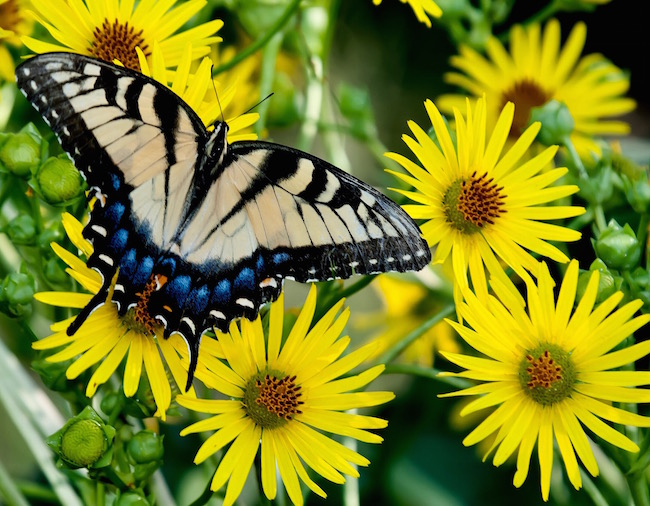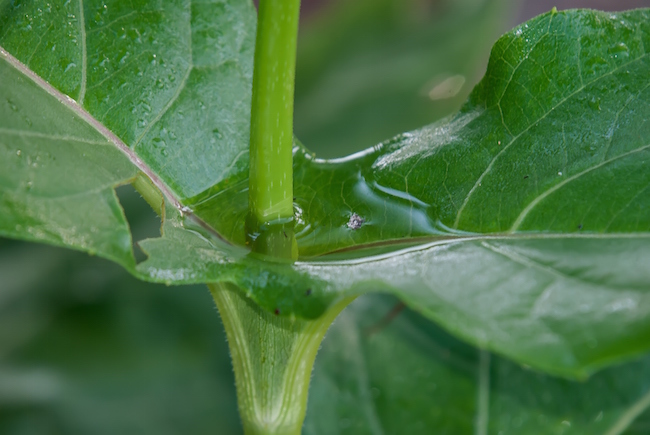When it comes to backyard wildlife, the cup plant does it all. To me, it is like the flag-bearing perennial for bees, butterflies and birds. It is a stalwart and is native in 34 states, from Louisiana, north to Canada and sweeping across all states east.
Its size makes it seem like it is the composite, or aster, that ate New York. It is big, bold and wonderful, and this is the time of the year it shines the most.
If you are interested in the cup plant but unfamiliar with the flower, it is known botanically as “Silphium perfoliatum” and, as I alluded above, is cold hardy from zones 3 through 9. It can grow tall — 4 to 10 feet — and colonize, so it is a plant for the back of the border. Here at the Coastal Georgia Botanical Garden at the Historic Bamboo Farm in Savannah, ours are around 7 feet.
Although it may be hard to imagine that they can dwarf a brown-eyed Susan, Rudbeckia triloba or Brazilan sage (Salvia guaranitica) are both considered large plants and terrific partners for the cup plant. Within close proximity, the pagoda flower (Clerodendrum paniculatum), Java glory bower (Clerodendrum speciosissimum) and baby lace (Hydrangea paniculata) all do their part to bring in hummingbirds, bees and butterflies.
Why is this called the “cup plant”? As the plant grows, it develops large, square stems that give the impression that they are piercing the center of the large leaves. There are actually two leaves without petioles that are attached to the stem, forming a perfect cup with which to collect rainwater. Small birds, like finches, take advantage of this natural reservoir of water. These same birds also feed on the seeds as they mature and disperse.
The blooms will eventually be covered in what may best be described as a “pollinating frenzy.” Every kind of bee, including honeybees by the hundreds, bumblebees and more, like wasps, are there doing their thing. On a recent morning visit to the Coastal Botanical Garden, I saw eastern tiger swallowtails, long-tailed skippers, fiery skippers and yellow sulphur butterflies. It was like a park for pollinators. Though I didn’t see any, everyone reports hummingbirds on the plants as well.
The nature lover will find the cup plant to be one of the most thrilling plants to incorporate into the landscape. Get a chair, a pair of binoculars and a camera, and you will be ready for a day of journaling.
Gardeners may need to adjust before planting. First, they must be ready to incorporate such a tall aster family member into the back of the border. Then, they must accept a colonizing racehorse of a plant, so to speak. Not only will gardeners have rhizomes spreading, but they will have reseeding. In other words, there will be some maintenance required to confine the plant to the space allotted.
Native plant nurseries sell the plants, and if we can buy them, so can you. They are also easy to start from seeds. Sow unstratified seeds in the fall or stratified seeds in the spring. If using stratification, give seeds a three-month cold, moist treatment in the refrigerator. Putting moist, coarse sand and seeds in a plastic bag is a good method. Then, choose a sunny location with good soil moisture.
Since this plant will be the backbone of your wildlife habitat or pollinator garden, choose companions that are not only beautiful but will incorporate the cup plants. I mentioned salvias and brown-eyed Susans, but Joe-Pye weeds, milkweeds and ironweeds native to your region would partner with cup plants well. Other favorites could be anise hyssops like ‘Blue Fortune,’ ‘Blue Boa’ and ‘Black Adder.’ They would give that complementary sizzle of opposite colors. Lastly, use the cup plant to create mystery in the garden by blocking a view and forming an area of transition.
The cup plant does it all for wildlife and pollinators, all the while showing dazzling 3.5-inch yellow blossoms. You have to agree that it is pretty doggone special.
Follow me on Twitter @CGBGgardenguru. Learn more about the University of Georgia Coastal Georgia Botanical Gardens at www.coastalgeorgiabg.org/.





